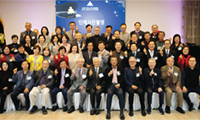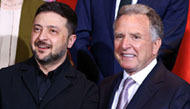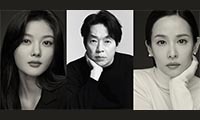ESTRELLITA BRODSKY
“Here was this kid, who probably felt like a little bit of an outsider
. . . who now felt proud about his heritage.”
Estrellita Brodsky’s life is not that of your typical graduate student. Instead of frugal dinners , there are $1,000-a-head museum galas. Home is an apartment on Park Avenue in Manhattan, not a share with roommates. And although she is hoping to finish her dissertation, which focuses on Latin American artists in postwar Paris, by January, Ms. Brodsky is not planning to enter the academic job market any time soon.
Instead she is devoting energy these days to figuring out how to use her wealth and connections as one of the city’s leading arts philanthropists, along with her scholarly perspective gained from her studies at New York University, to raise the profile of Latin American art.
For two years Ms. Brodsky has endowed the post of the Latin American art curator at the Museum of Modern Art, held by Luis Perez-Oramas. Her encouragement led Harvard University to create a position for a Latin American art specialist in its history of art and architecture department. Currently she is in discussions with the Harvard Art Museum about financing Latin American acquisitions.
Ms. Brodsky recently presided as chairwoman at the opening night on November 13 of Pinta, a Latin American art fair in its second year in New York. Mauro Herlitzka, a co-director of Pinta, said she was an obvious choice not just because of her prominence as a collector, philanthropist and society figure - she is married to the real estate scion Daniel Brodsky - but also because of her scholarly background.
“She’s very comprehensive in her understanding” of the Latin American art world, he said.“She supports it at MoMA, and she’s also involved with curatorship.”
Only in the last 15 years have scholars fully embraced the contributions of Latin American artists to 20th-century abstract movements. At the same time the rise of international art fairs has brought greater attention to contemporary artists working in Latin America.
Growing up in New York City in the 1950s and ‘60s, with parents who had immigrated from Venezuela and Uruguay, Ms. Brodsky, 56, said she learned how ignorant most of her young peers were about Latin America.
“It was pretty much, ‘Oh, were your parents Indians, living in the jungle-’ ” she said of her classmates in the fourth or fifth grade. Her great-great-grandfather on her mother’s side, Juan Idiarte Borda, was the president of Uruguay.
In 1995 a friend enlisted her to help organize an exhibition on the Taino, pre- Columbian inhabitants of the Caribbean, at El Museo del Barrio. She traveled to Haiti, the Dominican Republic, Puerto Rico and Cuba helping to arrange loans. The overall experience was transformative, she said.
In a visitors’ book at the exhibition, she recalled, “A little kid said, ‘My name is Taino, and I’m so happy now to learn what I’m named after.’ I thought that was so cute: Here was this kid, who probably felt like a little bit of an outsider because he had this strange name, who now felt proud about his heritage.”
Ms. Brodsky eventually rose to become the museum board’s chairwoman. She decided to go back to school for a doctorate and is completing her dissertation at the Institute of Fine Arts at N.Y.U.
Ms. Brodsky said she saw herself as part of a group of people who are helping to raise the status of Latin American art. With the growing number of Latin American immigrants in the United States, she suggested, their effort has gained momentum.“The timing is right,” she said.
스마터리빙
more [ 건강]
[ 건강]이제 혈관 건강도 챙기자!
[현대해운]우리 눈에 보이지 않기 때문에 혈관 건강을 챙기는 것은 결코 쉽지 않은데요. 여러분은 혈관 건강을 유지하기 위해 어떤 노력을 하시나요?
 [ 건강]
[ 건강]내 몸이 건강해지는 과일궁합
 [ 라이프]
[ 라이프]벌레야 물럿거라! 천연 해충제 만들기
 [ 건강]
[ 건강]혈압 낮추는데 좋은 식품
[현대해운]혈관 건강은 주로 노화가 진행되면서 지켜야 할 문제라고 인식되어 왔습니다. 최근 생활 패턴과 식생활의 변화로 혈관의 노화 진행이 빨라지고
사람·사람들
more
[송년행사 화보] “이웃과 함께 나누고 지인과 함께하니 행복”
KYCC13일 윌튼 플레이스 초등학교에서 열린 ‘한인타운청소년회관(KYCC) 홀리데이 카니발’이 성황리에 막을 내렸다. 올해는 KYCC 창립 …

[송년행사 화보] “ ‘손에 손잡고’ 한 해 마무리… 건강과 행복 기원”
전주고·북중남가주 전주고·북중 총동창회(회장 백규종)의 2025년 정기총회 및 송년회가 지난 14일 LA 작가의 집에서 성황리에 열렸다. 이날…
[송년행사 화보] “한 해를 마무리하며… 화기애애…
LA 러너스클럽LA 러너스클럽(회장 김두병)은 13일 작가의 집에서 80여명의 회원과 가족이 참석한 가운데 송년회를 마쳤다. 2007년 창립된…
[송년행사 화보] “웃음과 감사 가득 ‘훈훈’… …
한국학교총연합회미주한국학교총연합회(회장 이영숙)가 주최한 제43회 장기 근속교사 포상 및 송년의 밤 행사가 140여명의 교사들이 참석한 가운데…
[송년행사 화보] “친구야 반갑다… 선배님들 모두…
경남중고경남중·고등학교 남가주 동창회(회장 예해덕)는 지난 6일 송년회를 열고 동문 및 가족 60여 명이 참석한 가운데 끈끈한 우정을 확인했다…
많이 본 기사
- 크리스마스 연휴 겨울폭풍 남가주 연안 2~4인치 비
- LA산불 여파 ‘심각’ 지역 주민 건강악화
- “판공비 1만달러 전액 반환하겠다” 1
- 미 북서부는 홍수, 동부는 폭설 사태 비상
- 브라운대 한인학생, 총격참사 극적 생존
- LA 소파이 스테디엄 8경기 확정
- ‘브라운대 총기참사’ 뉴욕 한인학생도 총상
- 치솟는 원·달러 환율… 1,480원대 찍어
- 일본도 핵잠 도입 논의 본격화? 방위장관 미 해군기지 핵잠 시찰
- 위기의 트럼프 “내년봄 최대규모 세금환급…전례없는 경제붐 온다”
- 워싱턴 일원 소비 확 줄어들었다
- 뉴저지훈민학당‘김치 담그기 문화 체험 행사’
- 트럼프, 베네수엘라 정권 ‘테러 단체’ 지정
- 양정고 뉴욕동문회 송년회
- ‘우크라 전쟁 피해배상’ 국제기구 만든다
- 21희망재단 제7회 장학생 명단 발표
- 뉴욕광복회 김수현 신임회장 추대
- ‘천의 얼굴’ 루푸스… “젊은 여성, 이유 없는 발진·탈모 있으면 의심해야”
- “북VA 주택시장 가격 급등 없다”
- “왜 한국 자산 미국으로 옮겨야 하나”
- 올해 앵커 재산세 환급 163만명에 18억달러 지급
- 국제펜 한국본부 미동부지역위 겨울 문학제
- 트럼프 “내년봄 최대규모 세금환급…군… 2
- 중고차 주행거리 조작 ‘주의보’
- 리 장군 동상 철거한 자리에 흑인 소녀 바바라 존스
- “보이스피싱 이렇게 당한다”
- 설날, 공립학교 휴일 되나?
- 뉴욕주 안락사 합법화 초읽기 호쿨, “안전장치 마련되면 서명”
- 유홍준 국립중앙박물관장, 대한제국공사관 방문
- 시드니 총기난사범, 인도 출신 이민자
- 월드컵 방문객 ‘미국행’… 한국선 ESTA(전자 여행 허가서)로 입국 가능
- 강경화 주미대사 신임장 제정 트럼프, 이 대통령 안부 물어
- 리치몬드한인회 20일 ‘한인의 밤’ 행사
- ‘항염증 식단’ 정답은 균형… 전체적 패턴이 중요
- 버지니아 주하원 11지구 민주당 경선
- 아가페 노인복지센터 19-20일 작품 전시회
- [윌셔에서] 잠시 멈추어 서서
- 박나래 빠진 ‘나혼산’ 촬영 현장 어땠나.. “웃음 보장 100% 조합”
- 뱅크오브호프, 규모도 1위·봉사활동도 ‘으뜸’
- 통합 한국학교 MD ‘한국동요 부르기’ 대회
- “AI 활용 한국어 수업, 선택 아닌 필수”
- 비트코인, 역대 네번째 연간 하락세
- 내년에 집 팔려면, 어떤 준비가 필요할까?
- ‘신인감독’ 신드롬 어디까지?..김연경, 또 해냈다
- 박찬욱 ‘어쩔수가없다’, 아카데미 예비후보
- 5년 규칙은 옛말… 집 사고 10년은 보유해야 본전
- 한국 축구, 태백산급 고지대 난관… “손흥민 감아차기도 제동”
- “신뢰감 있는 이미지”..김도훈, 광고계 러브콜 쇄도
- ‘돈봉투 수수’ 민주당 전현직 의원들 2심 무죄…1심 뒤집혀
- 컨설팅 제왕 맥킨지 수천명 감원 칼바람
1/5지식톡

-
 ☝️해외에서도 가능한 한국어 선생님…
0
☝️해외에서도 가능한 한국어 선생님…
0이 영상 하나면 충분합니다!♥️상담신청문의♥️☝️ 문의 폭주로 '선착순 상담'만 진행합니다.☎️ : 02-6213-9094✨카카오톡ID : @GOODEDU77 (@골뱅이 꼭 붙여주셔야합니다…
-
 테슬라 자동차 시트커버 장착
0
테슬라 자동차 시트커버 장착
0테슬라 시트커버, 사놓고 아직 못 씌우셨죠?장착이 생각보다 쉽지 않습니다.20년 경력 전문가에게 맡기세요 — 깔끔하고 딱 맞게 장착해드립니다!장착비용:앞좌석: $40뒷좌석: $60앞·뒷좌석 …
-
 식당용 부탄가스
0
식당용 부탄가스
0식당용 부탄가스 홀세일 합니다 로스앤젤레스 다운타운 픽업 가능 안녕 하세요?강아지 & 고양이 모든 애완동물 / 반려동물 식품 & 모든 애완동물/반려동물 관련 제품들 전문적으로 홀세일/취급하는 회사 입니다 100% …
-
 ACSL 국제 컴퓨터 과학 대회, …
0
ACSL 국제 컴퓨터 과학 대회, …
0웹사이트 : www.eduspot.co.kr 카카오톡 상담하기 : https://pf.kakao.com/_BEQWxb블로그 : https://blog.naver.com/eduspotmain안녕하세요, 에듀스팟입니다…
-
 바디프렌드 안마의자 창고 리퍼브 세…
0
바디프렌드 안마의자 창고 리퍼브 세…
0거의 새제품급 리퍼브 안마의자 대방출 한다고 합니다!8월 23일(토)…24일(일) 단 이틀!특가 판매가Famille: $500 ~ $1,000Falcon: $1,500 ~ $2,500픽업 & 배송직접 픽업 가능LA…
케이타운 1번가
오피니언
 수잔 최 한미가정상담소 이사장 가정법 전문 변호사
수잔 최 한미가정상담소 이사장 가정법 전문 변호사 [수잔 최 변호사의 LIFE &] AI 시대 편리함에 안주하지 말자
 김도년 성균관대 건축학과 교수 스마트도시·건축학회장
김도년 성균관대 건축학과 교수 스마트도시·건축학회장 [로터리] 지멘스가 만드는 미래 동네

[여명] 금붕어를 키우는 오지선다형 수능
 허경옥 수필가
허경옥 수필가 [윌셔에서] 잠시 멈추어 서서
 양홍주 / 한국일보 논설위원
양홍주 / 한국일보 논설위원[지평선] 판다 없는 일본

[왈가 왈부] 쿠팡 김범석 “글로벌 CEO라 불출석”… ‘맹탕’ 청문회 불보듯
 정숙희 논설위원
정숙희 논설위원칠레에서 영국까지, 27년을 걷다
 마크 A. 시쎈 / 워싱턴포스트 칼럼니스트
마크 A. 시쎈 / 워싱턴포스트 칼럼니스트 [마크 A. 시쎈 칼럼] MAGA와 ‘힘에 바탕한 외교정책’
 김동찬 시민참여센터 대표
김동찬 시민참여센터 대표 [미국은 지금] 위기의 시대, 사회안전망은 최후의 방어선이다
1/3지사별 뉴스

‘브라운대 총기참사’ 뉴욕 한인학생도 총상
▶총상 입은 상황서도 동료학생 의식 잃지않도록 도와 ▶부친도 동문 “우리 가족에게 고통스러운 일”지난 13일 발생한 브라운대학교 총기난사(본보…
뉴욕주 안락사 합법화 초읽기 호쿨, “안전장치 마련되면 서명”

워싱턴 일원 소비 확 줄어들었다
올해 8월 워싱턴DC에 범죄와의 전쟁을 명분으로 주방위군이 본격적으로 배치된 가운데, 이 시기 이후부터 버지니아와 메릴랜드, DC 등 워싱턴 …
“북VA 주택시장 가격 급등 없다”

베이지역 스포츠팀, SF 한인회에 후원금
샌프란시스코 베이지역 한인회(회장 김한일)는 한인 메이저리거 이정후 선수의 소속팀인 샌프란시스코 자이언츠(San Francisco Giants…
불자커뮤니티 20일 청소년발표회및 송년회

오늘 하루 이 창 열지 않음 닫기 



















































.png)


댓글 안에 당신의 성숙함도 담아 주세요.
'오늘의 한마디'는 기사에 대하여 자신의 생각을 말하고 남의 생각을 들으며 서로 다양한 의견을 나누는 공간입니다. 그러나 간혹 불건전한 내용을 올리시는 분들이 계셔서 건전한 인터넷문화 정착을 위해 아래와 같은 운영원칙을 적용합니다.
자체 모니터링을 통해 아래에 해당하는 내용이 포함된 댓글이 발견되면 예고없이 삭제 조치를 하겠습니다.
불건전한 댓글을 올리거나, 이름에 비속어 및 상대방의 불쾌감을 주는 단어를 사용, 유명인 또는 특정 일반인을 사칭하는 경우 이용에 대한 차단 제재를 받을 수 있습니다. 차단될 경우, 일주일간 댓글을 달수 없게 됩니다.
명예훼손, 개인정보 유출, 욕설 등 법률에 위반되는 댓글은 관계 법령에 의거 민형사상 처벌을 받을 수 있으니 이용에 주의를 부탁드립니다.
Close
x